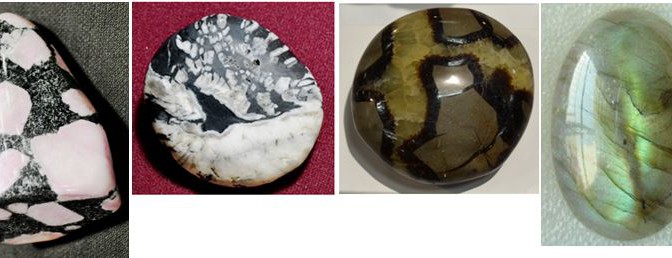Published in the July 2015 WCGMC Newsletter
I have a confession to make. Yes, I admit it, for the first few decades of my adult life I collected minerals while scoffing at the notion of cutting rocks and polishing their surface to produce symmetric reflective surfaces. Cabochons, smabochons, … spheres, smears, I would say, or something to that effect. Well, since joining the Wayne County Gem and Mineral Club I have come to realize that some rocks, even some minerals, are best displayed and enjoyed after they have been carved, sliced, ground, and polished. What is more, that process can be fun and there is art involved in the creation of a polished stone. I am not a total convert, I still cherish and generally prefer natural crystalline specimens, preferably on matrix and often in association with other minerals, but I am now capable of collecting, and yes even, horrors, purchasing a polished cabochon.
OK, with that admission of past guilt, or new guilt depending on your persuasion, I decided to peruse the GemFest floor for particularly interesting pieces that had been butchered by a saw and then beautified by some process of trimming and polishing. I found several that caught my fancy. But I must warn you, beauty, color, and symmetry are not enough. The rock or mineral must tell an interesting geologic story and just like a classic mineral specimen it must have a provenance, a banded agate from somewhere just won’t make my short list no matter how beautiful it might be. So what did I find?
MARSHMALLOW STONE
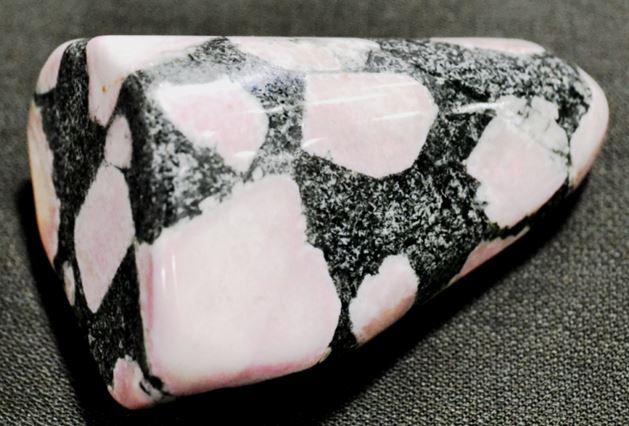
To a geologist this is a diabase porphyry (or dolerite porphyry if you are British!), just a garden variety igneous rock. It is a diabase because the groundmass (the fine grained material between the “marshmallows”) is high in calcium and sodium and low in potassium such that the finer grained minerals are plagioclase feldspar, biotite, hornblende and/or pyroxene. If there were more potassium it would be granite. It is the texture that generates the term porphyry. The larger marshmallows (geologists would call them phenocrysts) are plagioclase that crystallized first in the cooling magma and grew to appreciable size before the remainder of the magma solidified. The pinkish color is due to a later partial alteration of the plagioclase to clinozoisite (http://www.mindat.org/loc-253647.html). Because the second phase of crystallization occurred more rapidly, probably at a shallower depth, the groundmass minerals are smaller. This is a common texture in igneous rocks that undergo two stages of cooling and solidification and the term for an igneous rock with that character is porphyry.
I found this piece at the booth of Mike’s Minerals, Youngstown, OH. It is from Mindolah in Cue Shire, Western Australia, where it is quarried as ornamental stone. Yes, ornamental, but also unique, and marshmallow stone is indeed more descriptive than diabase porphyry.
CHRYSANTHEMUM STONE AND SEPTARIAN NODULE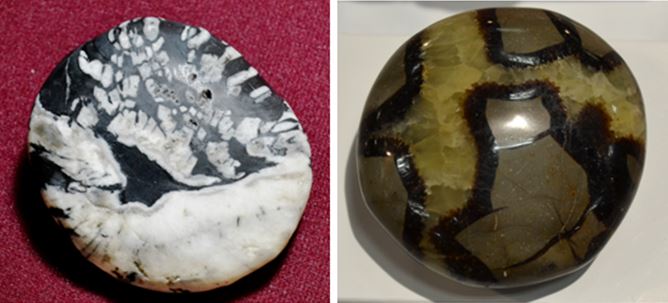
Sedimentary processes can also generate unique and interesting features that are amenable to the saw and the polishing wheel. The chrysanthemum stone above on the left formed when strontium-rich seawater penetrated buried, but non-lithified, organic calcareous muds in the seafloor. Cracks formed in the hardening mud and celestite (SrSO4) and calcite (CaCO3) were precipitated in the void space along the crack. The growing crystals pushed the ooze aside generating patterns that often resemble flowers. This particular stone was offered by Stones by Stalker of Tioga, PA and is from Permian age strata in the Hunan Province of China.
I am violating my requirement of provenance by including a Septarian Nodule that was offered by Canton Collectibles of Martinsburg, WV in this discussion. We do not know its actual provenance, but the perplexing story of a septarian nodule is too interesting to overlook. First, one needs to grow a concretion within a sedimentary sequence, a rock that is harder that its surroundings, generally cemented, and trending towards round in shape. Simply put, geologists can not agree on how that occurs. Is it from the inside out after nucleating on an organic fragment? Perhaps, but then radially oriented cracks often taper towards the margins indicating a stiffer margin.
And then we must crack the nodule and that mechanism is also controversial. Clay dehydration, gas escape as organic matter decays, shrinkage of the center with burial mineralization, and a host of exotic mechanisms have been proposed. Heck, they may all work under the correct circumstances. In this case, calcite precipitation within the cracked nodule occurred in two stages. The first left a very dark rind on the host dolostone. The latter final stage of cement filling calcite is a brilliant honey color and the crystals are larger.
AZURITE IN GRANITE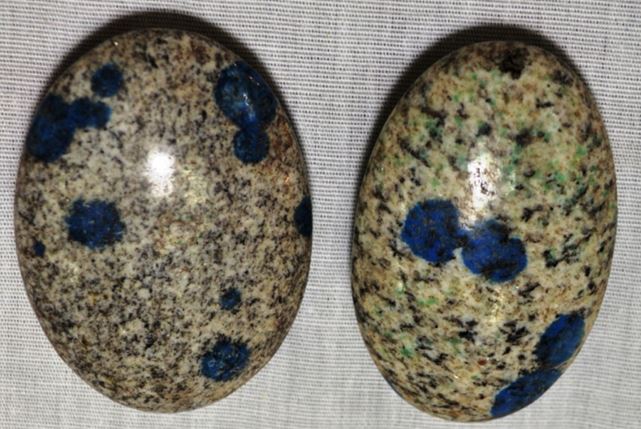
I researched this next one with a fair amount of skepticism, but learned my concerns were unfounded. John Diaz of DarkHorse Minerals had several polished granite pieces displaying splotches of azurite. The blue almost appears to have been added with a dye, but careful examination reveals that the copper carbonate mineral is present along grain boundaries and in tiny fractures within grains. They are from Pakistan, recovered in talus at high elevation alongside the second highest mountain in the world, K2, also known as Mount Godwin Austen (http://geology.com/gemstones/k2/). Malachite is also found in similar setting.
LABRADORITE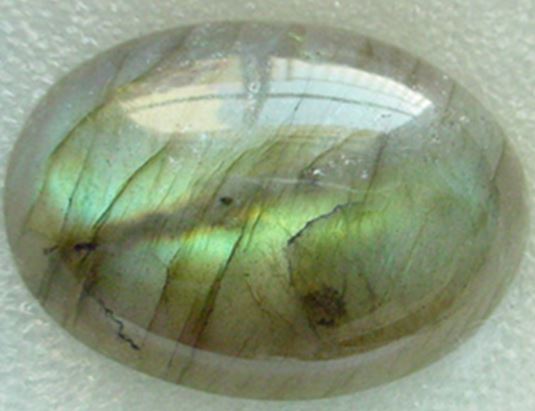
Of course there are many minerals that also display best when polished. One such mineral is labradorite. Actually labradorite is not a recognized mineral, at least not officially by the International organization responsible for such things, but rather it is a name given to an intermediate composition in the plagioclase series between end member minerals anorthite (CaAl2Si2O8) and albite (NaAlSi3O8). Labradorite is the term used for plagioclase that ranges between 50% and 70% anorthite component.
Although named for a type location in Paul’s Island, Labrador, Canada, this piece I saw (and purchased) was from Madagascar. It was offered by Malachite and Gems of Rochester, NY. The peculiar reflectance from submicroscopic planes in the mineral lattice are so unique to labradorite that the iridescent feature is called labradorsecence (http://en.wikipedia.org/wiki/Labradorite).
Space does not permit me to continue, at least not this month. But I ask you, what is your favorite polished stone? Do you like it for its features, its unusual origin, because you found it and cut it, or just because. Any answer is just fine.
References:
McBride, E.F., et. al., 2003, Calcite-cemented Concretions in Cretaceous Sandstone, Wyoming and Utah, Journal of Sedimentary Research, v. 73, n. 3, p. 462-483.
Various Mindat and Wikipedia sites were also accessed as noted in the text
